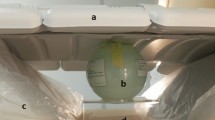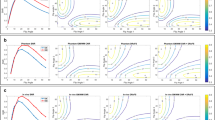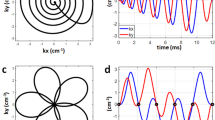Abstract
Object
In the present study the performance of the dual refocusing echo acquisition mode (DREAM) B1 + mapping sequence is evaluated for RF shimming in the abdomen at 3 T and validated against existing RF shim technology.
Materials and methods
In vivo experiments were performed on 19 normal volunteers using a clinical 3 T dual channel MRI system. For each volunteer three different B1 + mapping techniques [DREAM, actual flip angle imaging (AFI) and saturated double angle method (SDAM)] were employed for RF shimming of the liver and to subsequently assess the quality of the obtained RF shim settings in terms of the achieved B1 + homogeneity and accuracy of the mean B1 +.
Results
DREAM-based B1 + calibration led to an average homogeneity improvement of 39.1 % (AFI = 38.7 %, SDAM = 38.1 %) and a mean B1 + of 90.9 % of the prescribed B1 + (AFI = 88.9 %, SDAM = 92.0 %). The duration of the B1 + calibration scan was reduced from 30 s (AFI) and 15 s (SDAM) to 2.5 s (DREAM).
Conclusion
DREAM accelerates RF shimming of the liver by an order of magnitude without compromising RF shimming performance.








Similar content being viewed by others
References
Hoult DI, Phil D (2000) Sensitivity and power deposition in a high-field imaging experiment. J Magn Reson Imaging 12:46–67
Ibrahim TS, Lee R, Baertlein BA, Abduljalil AM, Zhu H, Robitaille PM (2001) Effect of RF coil excitation on field inhomogeneity at ultra high fields: a field optimized TEM resonator. Magn Reson Imaging 19:1339–1347
Katscher U, Börnert P, Leussler C, van den Brink JS (2003) Transmit sense. Magn Reson Med 49:144–150
Zhu Y (2004) Parallel excitation with an array of transmit coils. Magn Reson Med 51:775–784
Willinek WA, Gieseke J, Kukuk GM et al (2010) Dual-source parallel radiofrequency excitation body MR imaging compared with standard MR imaging at 3.0 T: initial clinical experience. Radiology 256:966–975
van der Meulen P, van Yperen GH (1983) A novel method for rapid pulse angle optimisation. Proceedings of the 5th annual meeting of SMRM, Montreal, Canada. (Abstract 1129)
Carlson JW, Kramer DM (1990) Rapid radiofrequency calibration in MRI. Magn Reson Med 15:438–445
Klose U (1992) Mapping of the radio frequency magnetic field with a MR snapshot FLASH technique. Med Phys 19:1099–1104
Insko E, Bolinger L (1993) Mapping of the radio frequency field. J Magn Reson, Ser A 103:82–85
Akoka S, Franconi F, Seguin F, Le Pape A (1993) Radiofrequency map of an NMR coil by imaging. Magn Reson Imaging 11:437–441
Stollberger R, Wach P (1996) Imaging of the active B1 field in vivo. Magn Reson Med 35:246–251
Sled JG, Pike GB (2000) Correction for B1 and B0 variations in quantitative T2 measurements using MRI. Magn Reson Med 43:589–593
Fernandez-Seara MA, Song HK, Wehrli FW (2001) Trabecular bone volume fraction mapping by low-resolution MRI. Magn Reson Med 46:103–113
Wang J, Qiu M, Constable RT (2005) In vivo method for correcting transmit/receive nonuniformities with phased array coils. Magn Reson Med 53:666–674
Cunningham CH, Pauly JM, Nayak KS (2006) Saturated double-angle method for rapid B1 mapping. Magn Reson Med 55:1326–1333
Jiru F, Klose U (2006) Fast 3D radiofrequency field mapping using echoplanar imaging. Magn Reson Med 56:1375–1379
Yarnykh VL (2007) Actual flip-angle imaging in the pulsed steady state: a method for rapid three-dimensional mapping of the transmitted radiofrequency field. Magn Reson Med 57:192–200
Helms G, Finsterbusch J, Weiskopf N, Dechent P (2008) Rapid radiofrequency field mapping in vivo using single-shot STEAM MRI. Magn Reson Med 60:739–743
Volz S, Nöth U, Rotarska-Jagiela A, Deichmann R (2010) A fast B1-mapping method for the correction and normalization of magnetization transfer ratio maps at 3 T. Neuroimage 49:3015–3026
Chung S, Kim D, Breton E, Axel L (2010) Rapid B1+ mapping using a preconditioning RF pulse with TurboFLASH readout. Magn Reson Med 64:439–446
Morrell GR (2008) A phase-sensitive method of flip angle mapping. Magn Reson Med 60:889–894
Sacolick LI, Wiesinger F, Hancu I, Vogel MW (2010) B1 mapping by Bloch-Siegert shift. Magn Reson Med 63:1315–1322
Nehrke K, Börnert P (2012) DREAM—a novel approach for robust, ultrafast, multislice B(1) mapping. Magn Reson Med 68:1517–1526
Nehrke K, Versluis MJ, Webb A, Börnert P (2014) Volumetric B(1) (+) mapping of the brain at 7 T using DREAM. Magn Reson Med 71:246–256
Sprinkart AM et al. Ultrafast volumetric B1+ mapping for improved RF shimming in 3 T body MRI. J Magn Reson Imaging. 4. doi:10.1002/jmri.24438
Wang J, Mao W, Qiu M, Smith MB (2006) Constable RT. Factors influencing flip angle mapping in MRI: RF pulse shape, slice-select gradients, off-resonance excitation, and B0 inhomogeneities. Magn Reson Med. 56:463–468
Nehrke K and Börnert P.(2012) Free-breathing abdominal B1 mapping at 3 T using the DREAM approach. Proceedings of International Society for Magnetic Resonance. 20. (Abstract 1920)
Childs AS, Malik SJ, O’Regan DP, Hajnal JV (2013) Impact of number of channels on RF shimming at 3 T. MAGMA 26:401–410 (Epub 2013 Jan 13)
Brunner DO, Pruessmann KP (2009) B1(+) interferometry for the calibration of RF transmitter arrays. Magn Reson Med 61:1480–1488
Malik SJ, Larkman DJ, Hajnal JV (2009) Optimal linear combinations of array elements for B1 mapping. Magn Reson Med 62:902–909
Nehrke K, Börnert P (2010) Eigenmode analysis of transmit coil array for tailored B1 mapping. Magn Reson Med 63:754–764
Tse DHY, Poole MS, Magill AW, Felder J, Brenner D, and Shah NJ (2014) Encoding methods for B1+ mapping in parallel transmission systems at ultra high field. In: Proceedings of International Society for Magnetic Resonance 22. (Abstract 4336)
Conflict of interest
Two of the authors, Peter Börnert and Kay Nehrke, are employees of Philips Research. The authors declare that they have no other conflicts of interest.
Author information
Authors and Affiliations
Corresponding author
Rights and permissions
About this article
Cite this article
Nehrke, K., Sprinkart, A.M. & Börnert, P. An in vivo comparison of the DREAM sequence with current RF shim technology. Magn Reson Mater Phy 28, 185–194 (2015). https://doi.org/10.1007/s10334-014-0454-3
Received:
Revised:
Accepted:
Published:
Issue Date:
DOI: https://doi.org/10.1007/s10334-014-0454-3




